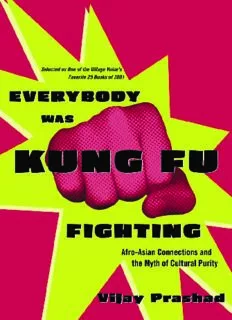
Everybody Was Kung Fu Fighting. Afro-Asian Connections and the Myth of Cultural Purity PDF
Preview Everybody Was Kung Fu Fighting. Afro-Asian Connections and the Myth of Cultural Purity
Everybody Was Kung Fu Fighting “In this brilliant exploration of the often surprising historical solidarities linking black and South Asian experiences,Prashad demolishes the conservative conceits of ethnic essentialism and so-called multiculturalism.Using clever examples from Rastafarianism to Bruce Lee,he shows how struggles against shared oppression in the crucibles of the Caribbean plantation and U.S.metropolis have shaped a dy- namic Afro-Asian interface in popular culture.In the usual dead zone of debate about identity politics,this little book is a refreshing oasis of original insight and unexpectedaffinity.” — ,authorof City ofQuartzand Magical Urbanism “Finally! A book that just might bring an end to all the silly talk of ‘identity poli- tics.’Vijay Prashad’s powerful,original essays reveal that neither brown skins nor cultural commonalities explain the long and dynamic history of Afro-Asian soli- darity.Rather,the answer lay in dreams of emancipation,dreams borne of Empire but nourished in the imaginations of so-called colored people who had to learn to trust each other in the trenches.This is one complicated and uncompleted journey weallneedtoknowabout.” — . . ,authorof Freedom Dreams and Yo’Mama’s Disfunktional! In 1992 the U.S. media was treated to of the Black Panthers, African- and Asian- “conflict” between blacks and Asians derived movements and cultures like all during the Los Angeles uprising. The others, have been porous rather than dis- event crystallized white-supremacist crete. stereotypes of blacks as the “problem” Building on the work of Robin D. G. minority and Asians as the “model.” Kelley, Prashad argues that these mo- In this landmark work, historian Vijay ments of exchange and cooperation be- Prashad refuses to engage the typical tween peoples of Asian and African de- racial discussion that matches people of scent demonstrate a need to reexamine color against each other while institution- the way we approach history. Multicultur- alizing the primacy of the white majority. alism is not enough because it assumes a Instead he examines more than five cen- certain cultural purity that doesn’t exist. turies of remarkable historical evidence of Prashad offers instead the theory of poly- cultural and political interaction between culturalism, in which our recognition of blacks and Asians around the world, in this history of cultural interchange allows which they have exchanged cultural and for solidarity forged by antiracism, rather religious symbols, appropriated personas than a simple lip service to diversity. and lifestyles, and worked together to achieve political change. From the Shiv- Vijay Prashad is director and associate ites of Jamaica, who introduced Ganja professor of international studies at Trinity and dreadlocks to the Afro-Jamaicans; to College and the author of The Karma of Ho Chi Minh the Garveyite; to Japanese- Brown Folk. He lives in Northampton, American Richard Aoki, a charter member Massachusetts. This page intentionally left blank e v e r y b o d y w a s k u n g f u f i g h t i n g AFRO-ASIAN CONNECTIONS AND THE MYTH OF CULTURAL PURITY V I J A Y P R A S H A D BeaconPress Boston Beacon Press 25 Beacon Street Boston,Massachusetts 02108-2892 www.beacon.org Beacon Press books are published under the auspices of the Unitarian Universalist Association of Congregations. © 2001 by Vijay Prashad All rights reserved First electronic reading edition 2002 Composition by Wilsted &Taylor Publishing Services Library of Congress Cataloging-in-Publication Data Prashad Vijay. Everybody was Kung Fighting : Afro-Asian connections and the myth of cultural purity / Vijay Prashad. p. cm. Includes bibliographical references and index. ISBN 0-8070-5015-6 ISBN 0-8070-5010-5 (hardcover :alk.paper) 1. African Americans—Relations with Asian Americans. 2.African Americans—Social conditions. 3. African Americans—Race identity. 4. Asian Americans—Social conditions. 5. Asian Americans— Race identity. 6. Racism—United States. 7. Race—Social aspects—United States. 8. United States—Race relations. 9. United States—Ethnic relations. I.Title. E185.615 .P73 2001 305.8´00973—dc21 2001001771 Contents ListofIllustrations vii TheForethought:RawSkin ix 1 TheStrangeCareerofXenophobia 1 2 TheAmericanIdeology 37 3 CooliePurana 70 4 TheMerchantIsAlwaysaStranger 97 5 KungFusion:Organizethe’HoodUnderI-ChingBanners 126 Notes 150 Acknowledgments 200 Credits 204 Index 205 This page intentionally left blank Illustrations IndianOceannobleman 1 MaoandDuBois 37 Coolielines,nineteenthcentury 70 YuriandMalcolm 97 NewHavencourthousesteps 126 This page intentionally left blank T h e F o r e t h o u g h t : R a w S k i n Ifthesnakeshedshisskinbeforeanewskinisready,nakedhewillbe intheworld,preytotheforcesofchaos.Withouthisskin,hewillbe dismantled,losecoherenceanddie.Haveyou,mylittleserpents,a newskin?1 MysenseofbeinganIndianintheworldismediatedthroughthestruggles ofSouthAfricansforliberation.Somucharetheyapartofmethatwhen ChrisHani,headoftheSouthAfricanCommunistPartyandamajorfigure intheANC,wasassassinatedin,Iwasbroughttotears.Asateenager, Irememberjoiningmyclassmatesinemotionaldiscussionsaboutthebattles againstapartheid.WetalkedaboutGandhi’stimeinthatfar-offlandand oftherelationshipbetweenIndiaandAfrica.Wesang,‘‘Amarraho,Nelson Mandela’’(‘‘Beeternal,NelsonMandela’’). WhenIcametotheUnitedStates,Ifellintothistradition,firstinthe antiapartheidmovementoftheearlysandthenwithElSalvadorsoli- daritywork.Iandmanyofmyimmigrantfriendsputourshoulderstothe wheelofthesestruggles,tojointhediverseworldoftheU.S.Left.Names likeSanjayAnand,AnnaLopez,NoelRodriquez,KarenMay,SidLemelle, andsomanyotherscomplicatedouridentificationwiththemainfightsof theday.ThoseofuswhocamefromothernationsfoundourAmericainthe heartoftheglobalfightsforjustice.Thistendencytoworkacrossthelines thatdivideuscontinuesinthefabricofthesocialjusticemovementsinthe UnitedStates,whetherthroughtheconceptof‘‘allies’’inthequeerliberation movementorelseincross-ethnicformationssuchasAsiansforMumiaand theCenterforThirdWorldOrganizing.2 But all people ofcolor do not feel that their struggleis a shared one. SomeofmySouthAsianbrethren,forexample,feelthatweshouldtakecare ofourownandnotworryaboutthewoesofothers,thatweshouldearnas muchmoneyaspossible,slideundertheradarofracism,andcareonlyabout theprospectsofourownchildren.TomanyofusfromIndia,thisisanun- comfortablebargain,butnonethelessitisonethatisnotunfamiliarinour timesamongallpeople.3 Whitesupremacyreigns,asitdidthen,andblacknessisreviled.Who canbegrudgethedesireamongpeopletoseekfellowshipintheirnewsociety, tothrowthemselvesintotheculturalworldsoftheplaceinwhichtheylive?
Description: